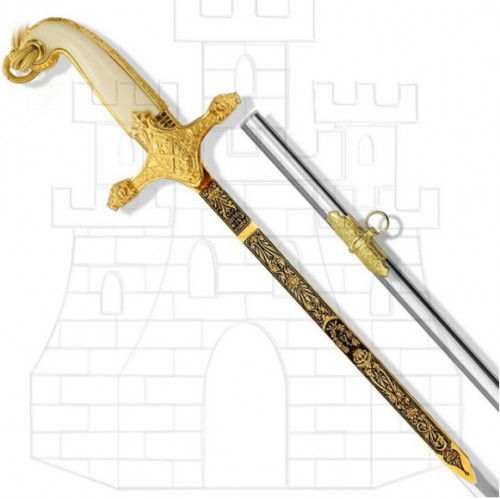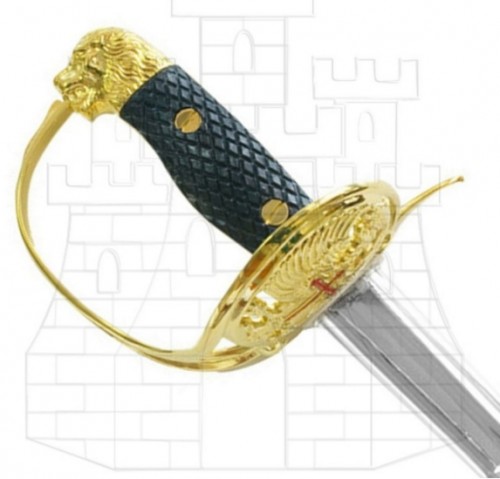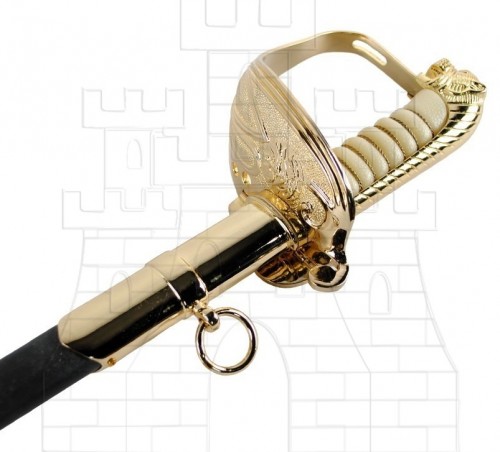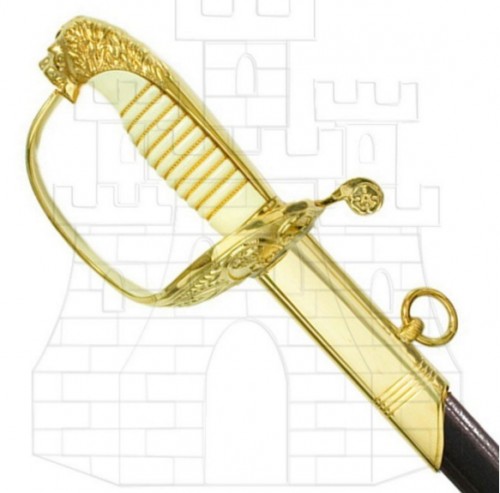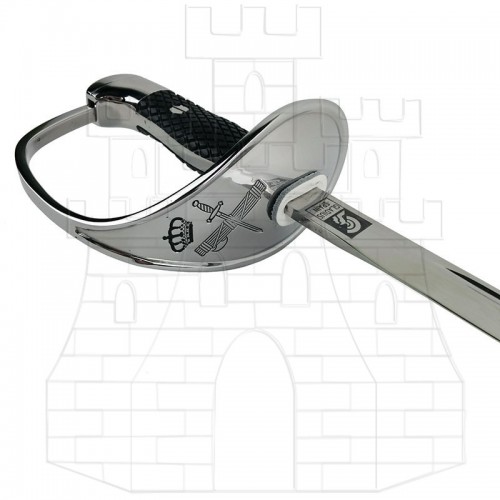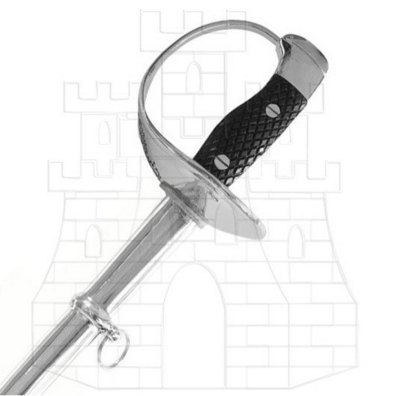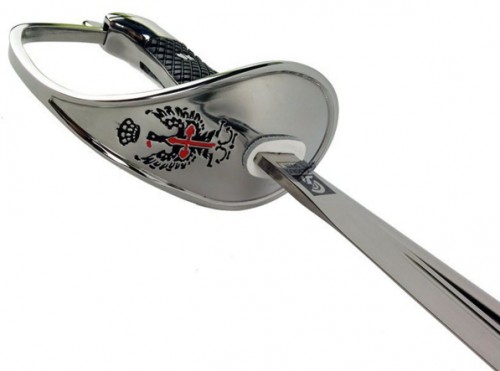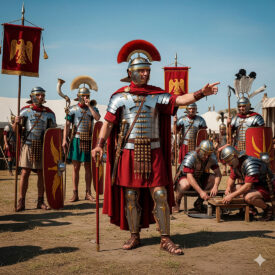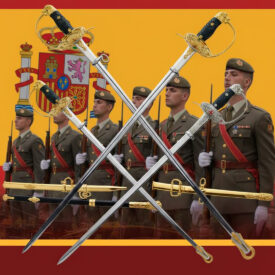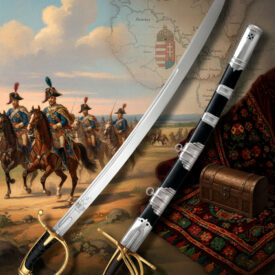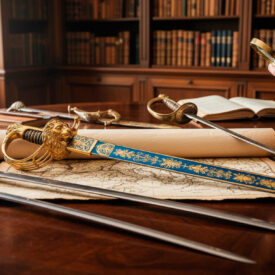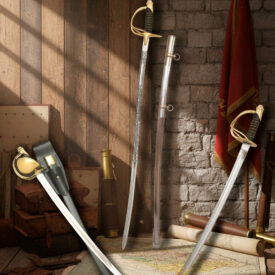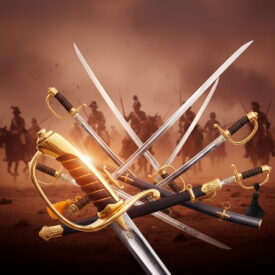They say that steel took the shape of the cavalry charge: a curved, light, and lethal blade, designed to cut with the same decisiveness with which a rider crossed the plains. This story is not just a myth; it is the living history of military sabers.
Why do sabers continue to fascinate historians, collectors, and military personnel? Because they condense technique, aesthetics, and symbolism into a single piece. In this article, you will discover their origin, their technical evolution, their role in historical tactics, the most relevant variants, and how they came to be a ceremonial emblem that survives today.
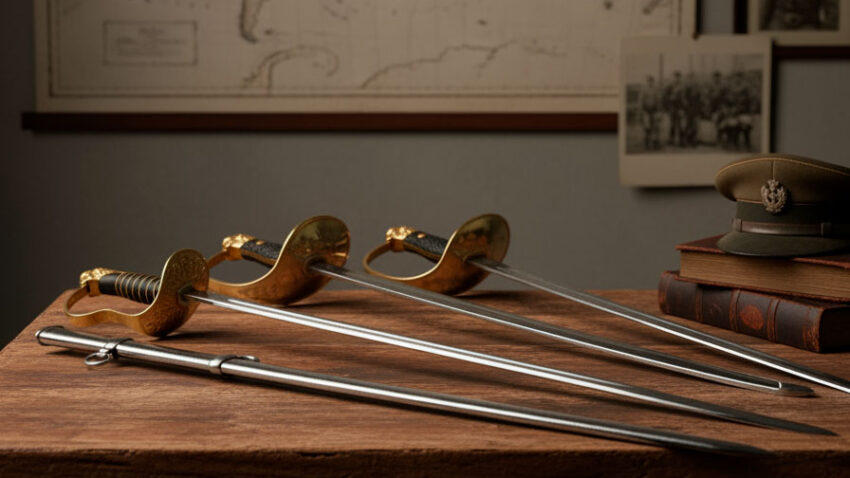
A curved blade that came from the steppes
The saber does not emerge from nothing; it is the answer of smiths and riders to the needs of mounted warfare. Its single-edged and characteristic curved blade was the perfect solution for striking with speed and detaching the weapon without it getting stuck in armor or bodies. This mechanical advantage transformed equestrian warfare in Europe, the Middle East, and Asia.
In this journey, we combine legend, technical data, and military context so that you understand why a saber is, at the same time, a combat tool and a symbol of command and honor.
What you will learn in these pages:
-
Origin and historical dissemination of the military saber.
-
Anatomy and materials: how it was designed to cut and last.
-
Combat tactics and techniques (mounted and on foot).
-
Main national variants and their meaning.
-
The saber as a ceremonial emblem and its presence in Spain.
The saber: detailed chronology of events and models
| Era/Date | Event |
|---|---|
| 5th-9th Century AD | |
| 5th-9th Century | Origin of the saber: the curved saber emerges in the steppes of Central Asia among nomadic peoples (Scythians, Huns). |
| 7th Century | Arrives in the Middle East through Arab traders. |
| 9th Century | Spreads through Asia and North Africa with Islamic conquests; used by Huns, Avars, Cumans, Bulgars, Turks, and Hungarians. |
| 12th Century | |
| 12th Century | The saber is introduced in China, India, and Rus, again by nomadic peoples. |
| 16th Century | |
| 16th Century | Adoption in Europe: Hungarian hussars, light cavalry, begin to use the saber, influencing other European armies. |
| 1576 | Stephen Báthory creates the Polish Winged Hussars and reforms the army; the first saber manufacturers are introduced in Poland; the saber becomes a symbol of nobility and strength. |
| Late 16th Century | Luis Pacheco de Narváez publishes a treatise on fencing. |
| 17th Century | |
| 1618-1648 | Thirty Years’ War: the saber consolidates as the standard weapon of light cavalry in Europe. |
| 17th Century | Saber fencing reaches its peak in Poland, developing the “art of the cross”. |
| 1683 | John III Sobieski of Poland, with imperial aid, defeats the Ottoman Empire in Vienna, highlighting the effectiveness of the Polish saber. |
| 1686 | Francesco Antonio Marcelli publishes Regole Della Scerma, with a chapter on the use of the saber in the 17th century. |
| Late 17th Century | François-Paulin Dalairac observes Polish skill and their training with palcaty. |
| 1697 | August II the Strong, King of Poland, promotes the spread of saber fencing in Saxony and Prussia. |
| 18th Century | |
| Late 18th Century | Great Britain designs the “Light Cavalry, Pattern 1796” saber, manufactured in large quantities and used in numerous campaigns. |
| 1775-1790 | Production of Dragoon sabers in Virginia with stirrup hilt and lion’s head pommel; some marked “POTTER” in New York. |
| 1776 | Several U.S. states form mounted militia units. |
| 1777 | The U.S. Congress authorizes the formation of four regiments of light dragoons. |
| 1781 (Oct) | Cornwallis’s surrender at Yorktown; American cavalry gradually decreases after the event. |
| 1784 (Jun) | Congress reduces the U.S. army to approximately 100 officers and men. |
| 1786 | Congress authorizes an army of just over 2,000 men. |
| 1792 | Congress increases the army’s strength to 5,000 men, including a troop of dragoons in each sub-legion. |
| 1793 (Dec) | Henry Knox reports 1,344 swords in storage, of which 478 are cavalry sabers. |
| 1794 (Apr 2) | Congress approves the purchase of weapons from England and Germany; the first national arsenal is established in Springfield, Massachusetts. |
| 1795 | John Miles moves to Pennsylvania and manufactures muskets, pistols, and swords. |
| 1798 | Congress increases the army including a full regiment of light dragoons; contract to Nathan Starr, Sr. for 2,000 sabers; in addition, 1,000 swords with Buel & Greenleaf completed in early 1799. |
| 1798-99 | Egyptian Campaign: the French are said to introduce “Turkish-style” sabers among European officers. |
| 19th Century | |
| Early 19th Century | “Turkish-style” sabers appear in Spain with very curved blades and no factory marks. |
| 1800-1802 | The U.S. Congress reorganizes the army, eliminating light dragoons. |
| 1801-1802 | Virginia acquires about 1,000 cavalry sabers from John Miles, Sr. |
| 1802 | The Virginia Manufactory begins operation. |
| 1803 | Militia report indicates 12,231 sabers in stock in the states. |
| 1804 | Production of the first model Virginia Manufactory saber begins. |
| 1806 | Production of the second model Virginia Manufactory saber begins. |
| 1807 (May 17) | 6,000 English troop sabers Model 1796 are received in Colberg, Prussia, for Von Schill and Blücher’s hussars. |
| 1807 (Dec 9) | The U.S. government contracts with William Rose for the manufacture of 2,000 cavalry sabers. |
| 1807 (Treaty of Tilsit) | After Napoleonic victories, Prussia loses territory; England supplies thousands of Model 1796 sabers to Prussia. |
| 1808 | Production of the third model Virginia Manufactory saber begins; Spanish War of Independence; the U.S. Congress authorizes an increase in the army including a regiment of dragoons. |
| 1811 | Prussia adopts the Model 1811 saber (“Blücher saber”), a copy of the English Model 1796. |
| 1812 (Jun) | War between the U.S. and Great Britain; two dragoon regiments are authorized (reduced to one in 1814). |
| 1812 | Contracts: William Rose for 500 sabers and Nathan Starr for 5,000. |
| 1813 | 10,000 English troop sabers are sent to Prussia. |
| 1813 (Oct) | Battle of the Thames: Kentucky mounted volunteers break the British line. |
| 1814 (Mar) | General Jackson uses 900 mounted Tennessee militiamen against Creek Indians in Alabama. |
| 1815 | The first official Spanish saber models for Cavalry are approved (mounted sword for Line Cavalry and saber for Light Cavalry) with officer variants. |
| 1815 (Jun 18) | Battle of Waterloo: English and Prussian sabers (Model 1811) used against Napoleonic troops. |
| 1815-1822 | Royal Household forces equipped with sword and saber models with three-branch guards. |
| 1815-1825 | The first type of hilt with a spurred pommel and tail down to the ferrule is produced for Cavalry and Artillery Officers. |
| 1817 | The “flanker brigade” of the Royal Household is expanded with a curved blade saber model. |
| 1818 (Dec) | The U.S. government contracts with Nathan Starr for 10,000 sabers, delivered between 1820 and 1822. |
| 1822 | Royal Household forces are disbanded. |
| 1824 | Johann Adolph Ludwig Werner publishes Versuch einer theoretischen Anweisung zur Fechtkunst im Hiebe, describing the “Polish or Hellish Fourth”. |
| 1825 | King’s Personal Guards restored and equipped with models based on the French Model 1822 saber; creation of the Royal Guard Cavalry Division with 1825 models. |
| 1825-1841 | Royal Body of the King’s Personal Guards uses sabers with a 4th type hilt (adjusted to that of the French saber of 1822). |
| 1825-1870 | Second type of hilt (pommel with cap and tail down to the ferrule) used on officer sabers. |
| 1826 | Nathan Starr ceases manufacturing sabers for the U.S. government and begins manufacturing firearms. |
| 1828 | Model of side sword for Artillery officers and cadets. |
| c.1830 | Michał Starzewski writes an unfinished treatise On Fencing. |
| 1831 | The “skirmisher brigade” reinforces the Royal Body of the King’s Personal Guards. |
| 1832 | Approval of the “mounted sword Md. 1832 for Line Cavalry”; Nathan Ames receives his first government contract for foot artillery swords. |
| 1833 (Mar) | The U.S. Congress authorizes a dragoon regiment for border defense. |
| 1833 | Ramón de Salas publishes Prontuario de Artillería, mentioning the blade for “Artillery Officer’s Sword” produced in Toledo. |
| 1834 (Feb) | Nathan Ames receives a contract for dragoon sabers. |
| 1836 | A second U.S. Dragoon regiment is authorized for the war against the Seminole Indians in Florida. |
| 1838 | The Spanish Army’s General Staff Corps is definitively organized. |
| 1840 | Approval of the “saber Md. 1840 for Light Cavalry”; the royal decree of May 30 details the “Turkish-style” saber for Generals and Brigadiers. |
| 1840s | Development of the breech-loading carbine and the revolver pistol, replacing the saber as the primary cavalry weapon. |
| 1842-1845 | Period of relative calm for U.S. dragoon regiments. |
| 1843 (Jan 26) | Spanish Army uniform regulations describing a straight saber type “Puerto-Seguro” for Generals. |
| 1843 | Models of generic side swords for officers of various branches. |
| 1844 | Saber model for Spanish Navy officers (1844-57). |
| 1845 | Nathan Ames delivers the first Model 1840 sabers. |
| 1846 (May) | The U.S. Congress authorizes the creation of a regiment of mounted riflemen. |
| 1849 | The rifleman’s knife is developed. |
| 1850 | Claudio del Fraxno and Joaquín de Bouligny define the saber with a three-branch guard as an “Officer of Cavalry model”. |
| 1853-1866 | Publication of the Illustrated Dictionary of Artillery by Luis de Agar and Joaquín de Aramburu, including models of sabers for officers and artillery. |
| 1854 | The Charge of the Light Brigade in the Crimean War highlights the vulnerability of cavalry to modern artillery. |
| 1855 | The “Military Agenda” cites only the side sword for Artillery Officer; a “Turkish-style” model is adopted for the Horse Artillery Brigade. |
| 1856 | The Toledo Factory tariff includes Artillery Officer sabers; Ames Manufacturing Company contracts the new pattern delivering the first thousand in 1857. |
| 1857 | The English saber Model 1796 is theoretically withdrawn from service in Prussia. |
| 1860 | Cavalry troop saber model. |
| 1861 | Side sword and dagger model for General Staff officers. |
| 1861-1865 | The U.S. government acquires approximately 392,700 cavalry sabers, mainly of the 1860 model. |
| 1862 (Jun 17) | Approval of the Artillery Officer’s saber, model 1862, and new model for horse Artillery troop. |
| 1864 | The Grenadiers cease sharing the “bombeta” with the Artillery Corps. |
| 1866 (Jul) | The U.S. Congress authorizes four additional regular cavalry regiments. |
| 1870-1871 | Campaigns with France where Blücher sabers were used. |
| 1871 (Jun 7) | Toledo Factory tariff includes saber models for officers (possible date error in an entry). |
| 1872 | Suspension of the use of Model 1862 sabers for mounted artillerymen; replaced by Model 1860 for Light Cavalry. |
| 1881 (Dec 30) | Uniformity regulations for the General Staff of the Army introduce a narrow-basket saber, unique model for Generals and Brigadiers. |
| 1889 | Denominations of Field Marshals and Brigadiers disappear, replaced by Major General and Brigadier General. |
| Late 19th Century | The saber remains an article of use for the cavalryman, although often not carried when action is anticipated. |
| 1891 | The Artillery Officer’s saber, Model 1862, is modified by reducing its scabbard rings to one. |
| 1898 | Spanish-American War: the Rough Riders become famous. |
| 1899-1901 | Philippines: cavalry participates in action. |
| 20th Century | |
| 1901 | The U.S. Congress authorizes five additional cavalry regiments. |
| 1904 | The U.S. army contracts with Ames Sword Company for 20,000 light cavalry sabers (Model 1906). |
| 1908 (Sep 23) | Generals regain the use of “Turkish-style” sabers according to the Uniformity Regulations for the General Staff of the Army. |
| 1909 (Aug 24) | New “Turkish-style” saber model described in the Uniformity Regulations for the Cavalry Arm for certain hussar regiments. |
| 1911 | “Blücher” sabers from war stock put up for sale in the ALFA catalog. |
| 1913 | The U.S. army produces the Patton Saber (Model 1913), designed by George S. Patton. |
| 1914 (First months) | Brief resurgence of the saber at the start of World War I. |
| 1918 (Mar) | Landers, Frary and Clark contract 15,000 swords. |
| 1920s-1930s | U.S. cavalry experiments with the saber, including an experimental model in 1931. |
| 1920 | Polish-Soviet War: the saber in Polish hands achieves many victories. |
| 1931 (May 7) | Changes in the Spanish military uniform: hilts with shields or royal crowns must be changed to mural crowns. |
| 1931 (Jun 27) | Particularization of changes in the Uniformity Regulations of 1926, modifying the Generals’ saber. |
| 1934 (Apr 18) | The U.S. army decides to discontinue the saber as a cavalry weapon and discard it completely. |
| 1934 (Jul 2) | The emblem of crossed cannons on Artillery sabers is replaced by the “bombeta” or flaming grenade without a crown. |
| 1939 (Sep) | The Polish saber still achieves victories in early World War II combats. |
| 1940-1941 (Winter) | U.S. mounted units make their last appearance in force in Louisiana maneuvers. |
| 1942 (Mar) | The office of the Chief of Cavalry of the U.S. is abolished and the remaining mounted units are dismounted. |
| 1943 (Jan 26) | Spanish Army Uniformity Regulations put an end to “Artillery Officer’s” sabers and approve a unique sword-saber model for Army Chiefs and Officers. |
| 1946 | Saber model for Spanish Air Force officers. |
| 21st Century | |
| Present | The saber is mainly preserved as a ceremonial weapon in parades, promotion ceremonies, and other official acts; interest in historical martial arts is growing. |
Anatomy of the saber: each part tells a story
The saber is not a simple blade; it is a balanced set of elements designed for a purpose. Knowing its anatomy helps to understand why certain forms persisted for centuries.
The blade
Curved blade, a sharp edge and a blunt false edge. The triangular or T-section offered rigidity and control. The typical cavalry length (80-90 cm) balanced reach and maneuverability.
The hilt and the guard
Ergonomic hilts, some with a thumb-notch on the quillon, and handguards in the form of a basket or scoop to protect the hand at a gallop. Officer’s sabers incorporated noble materials and ornamentation that completed their symbolic function.
Materials and forging: the science behind the shine
The quality of the steel and the tradition of the smith determined the effectiveness of a saber. Carbon steel and, in earlier times, steels worked with techniques similar to those of Damascus, offered the desired balance between edge and flexibility.
Scabbards evolved from leather wrapped with fittings to lacquered metal scabbards that protected the blade from wear and weather.
Practical example: a saber with a well-tempered blade resisted impact without breaking; a blade that was too hard would chip; too soft, it would lose its edge. Balance was the smith’s mastery.
Tactics and techniques: how the saber was used in combat
The saber was the weapon of cavalry and mobile units. Techniques favored cutting from the gallop, continuity of movement, and rapid recovery of the weapon.
Most common equestrian techniques
-
Diagonal cuts leveraging the horse’s inertia.
-
The “moulinet cut”: a wide swing to control the space around the rider.
-
Combinations with fire: pistols and carbines opened distances before close-quarters combat.
On foot, when the saber was adopted by infantry or officers, its use adapted to quick parries and responses more characteristic of modern fencing.
Regional variants: from scimitar to shamshir
The saber is not uniform: each culture transformed it. The Arab scimitar, the Persian shamshir, the Turkish kilij, the Indian tulwar, or the Japanese katana are variations that share curvature as a functional and aesthetic feature.
Quick comparison
| Type | Curvature | Primary Use | Advantage |
|---|---|---|---|
| Light cavalry saber | High | Fast attacks and maneuver | Greater cutting effect and maneuverability |
| Heavy cavalry saber | Moderate | Clashes and breaking lines | More striking power and durability |
| Ceremonial/officer saber | Variable (often minor) | Parades, rank insignia | Aesthetics and symbolism |
The saber in Spain: tradition, units, and symbols
In Spain, the saber has been linked to military tradition from the 18th century to modern times. Specific models were manufactured for cavalry, artillery, infantry, Civil Guard, and Royal Guard. Today, it remains a gala element that identifies ranks and corps.
The saber in Spain carries emblems: the artillerist’s “bombeta”, the quillon guards on officer’s sabers, and the “Turkish-style” variations for certain ranks. It is no coincidence that in military academies, the saber is presented to graduates with mottos that evoke honor and responsibility.
The symbolism of the saber: command, truth, and duty
Each component of the saber carries meaning: the hilt as a symbol of truth, the guard as a balance between justice and peace, and the blade that invokes duty and the legitimacy of using force in defense of order. This symbolism is expressed in ceremonial rituals and in civil acts linked to military life.
Maintenance, conservation, and collecting
A well-preserved saber requires steel cleaning, humidity control, and scabbard maintenance. Collectors value both combat pieces and historical replicas: the patina, forging marks, and engravings are material documents that tell lives.
If you observe a blade, look for the temper, flexibility, and signs of repair that reveal its use; an original scabbard or hilt enhances the story the piece tells.
The saber today: ceremony, legacy, and historical practice
Although the saber ceased to be a weapon of war in the 20th century, its ceremonial presence is undeniable. Parades, oaths, promotions, and the famous “arch of sabers” at military weddings keep the tradition alive. Furthermore, the resurgence of historical martial arts (HEMA) has brought technical practice back to many enthusiasts.
The saber is a bridge between past and present: a functional object that became a sign of identity and community.
Recommendations for students and enthusiasts
-
Study the chronology: identifying the period of a blade facilitates its cataloging.
-
Familiarize yourself with technical terms: quillon, ferrule, ferrule, pommel, guard.
-
Value the provenance and markings: many pieces retain the manufacturer’s or workshop’s seal.
The military saber is more than a bladed weapon; it is the imprint of equestrian tactics, technological evolution, and the ritual of command. From the plains of Central Asia to modern parades, its curve tells stories of speed, mastery, and honor. When you observe one, remember that every notch, every polish, and every engraving are fragments of a narrative that spans centuries.
Keep exploring, observe chronologies, compare models, and let the stainless history of steel speak to you. Perhaps you will find in an ancient hilt the voice of a rider who, centuries ago, challenged history with a saber in hand.
